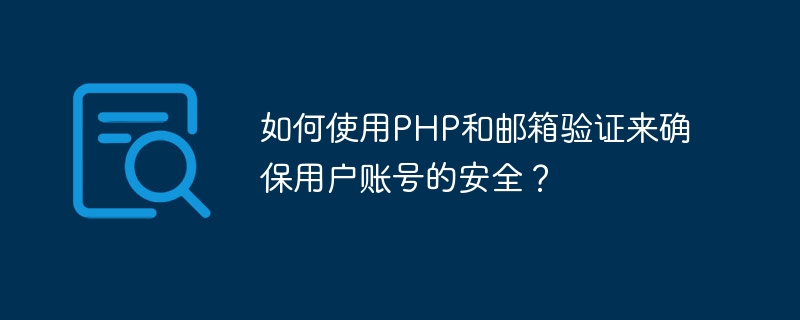

How to use PHP and email verification to ensure the security of user accounts?
With the rapid development of the Internet, the security of user accounts has become more and more important. In order to ensure the security of user accounts, a common method is to use email verification. This article will introduce how to use PHP and email verification to ensure the security of user accounts, and give corresponding code examples.
1. What is email verification?
Email verification is to confirm the authenticity and validity of the user by sending a verification link or verification code to the email address provided by the user when registering, allowing the user to click on the link or enter the verification code for verification. This prevents malicious registration and illegal access.
2. How to implement email verification?
First of all, in the user registration page, the email input box should be added, and a click event should be added to the registration button. When the user clicks the registration button, execute Verify email related operations.
HTML code example:
<form action="register.php" method="POST"> <input type="email" name="email" placeholder="请输入邮箱地址" required> <input type="submit" value="注册"> </form>
After the user fills in the email address, the background needs to generate a unique Verification link. The generated link can be a link containing the user ID and verification token, for example: http://example.com/verify.php?id=123&token=ABC123. The link is then emailed to the user.
PHP code example:
<?php
$email = $_POST['email'];
$userId = 123; // 这里假设用户的ID为123
$token = md5(uniqid()); // 生成一个唯一的验证标识
$verifyUrl = "http://example.com/verify.php?id={$userId}&token={$token}"; // 生成验证链接
// 发送验证邮件
$subject = "请验证您的邮箱";
$message = "请点击以下链接完成邮箱验证:{$verifyUrl}";
$headers = "From: noreply@example.com";
mail($email, $subject, $message, $headers);
?>When the user clicks the verification link, he needs to pass the user ID and verification in the link ID to verify the validity of the mailbox and save the verification results to the database.
PHP code example:
<?php
$userId = $_GET['id'];
$token = $_GET['token'];
// 验证链接的有效性
// ...
// 更新用户账号的验证状态
// ...
// 跳转到登录页面
header("Location: login.php");
exit;
?>In the user login page, you should check whether the user has completed the email verification. If verification is not completed, you cannot log in. You can provide the user with a prompt to resend the verification email.
PHP code example:
<?php
// 检查用户是否已经验证邮箱
if (!$user->isEmailVerified()) {
echo "您的邮箱尚未验证,请先完成邮箱验证。";
echo "<a href="resend_verification.php?id={$userId}">重新发送验证邮件</a>";
exit;
}
// 其他登录处理
// ...
?>Through the above steps, we can use PHP and email verification to ensure the security of the user account. After users register, they need to click on the verification link to complete email verification to ensure the authenticity and validity of their account. This can prevent malicious registration and illegal access and improve the security of user accounts.
The above is a simple example, which needs to be modified and improved according to specific needs in actual applications.
The above is the detailed content of How to use PHP and email verification to ensure the security of user accounts?. For more information, please follow other related articles on the PHP Chinese website!